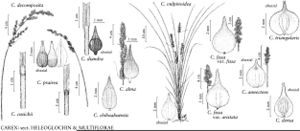Carex vulpinoidea
Fl. Bor.-Amer. 2: 169. 1803.
Culms to 100 cm × 2 mm, scabrous. Leaves: sheath fronts spotted red-brown or pale brown, apex truncate or short-convex, membranous or hyaline, rugose; ligule retuse or rounded, to 2 mm, free limb to 0.2 mm; blades 120 cm × 5 mm, longer than flowering stem. Inflorescences spicate, (3–)7–10 cm × 15 mm, with 10–15 branches, the proximal branches distinctly separate; the proximal internode to 25 mm; bracts setaceous, those subtending at least the proximal lateral branches conspicuous. Scales pale brown, hyaline, awn to 3 mm. Perigynia green to pale brown, veinless on both faces or 3-veined abaxially, body ovate or elliptic, 2–3.2 × 1.3–1.8 mm, base obtuse; beak 0.8–1.2 mm, 1/3–1/2 length of perigynium. Achenes red-brown, ovate, 1.2–1.4 × 1 mm, glossy. 2n = 52.
Phenology: Fruiting Jul–Aug.
Habitat: Seasonally saturated or inundated soils in open habitats, wet meadows, marshes, roadside ditches
Elevation: 0–1800 m
Distribution

St. Pierre and Miquelon, Alta., B.C., Man., N.B., Nfld. and Labr., N.S., Ont., P.E.I., Que., Sask., Ala., Ariz., Ark., Calif., Colo., Conn., Del., D.C., Fla., Ga., Idaho, Ill., Ind., Iowa, Kans., Ky., La., Maine, Md., Mass., Mich., Minn., Miss., Mo., Nebr., N.H., N.J., N.Mex., N.Y., N.C., N.Dak., Ohio, Okla., Oreg., Pa., R.I., S.C., S.Dak., Tenn., Tex., Vt., Va., Wash., W.Va., Wis., Wyo., Mexico (Sonora), introduced to Europe, New Zealand.
Discussion
Carex vulpinoidea is widely distributed in North America and frequently grows as a weed in wet roadside ditches and fields. It is quite variable, particularly in the degree to which the spongy tissue lateral to the achene is developed. The development of that tissue determines the shape of the perigynium and the degree to which the perigynium appears to contract into the achene, as discussed by F. M. B. Boott (1858–1867). The flowering stems shorter than the leaves, the pale brown, elliptic perigynia, and the preference for moist substrates of C. vulpinoidea readily distinguish it from C. annectens.
Selected References
None.
